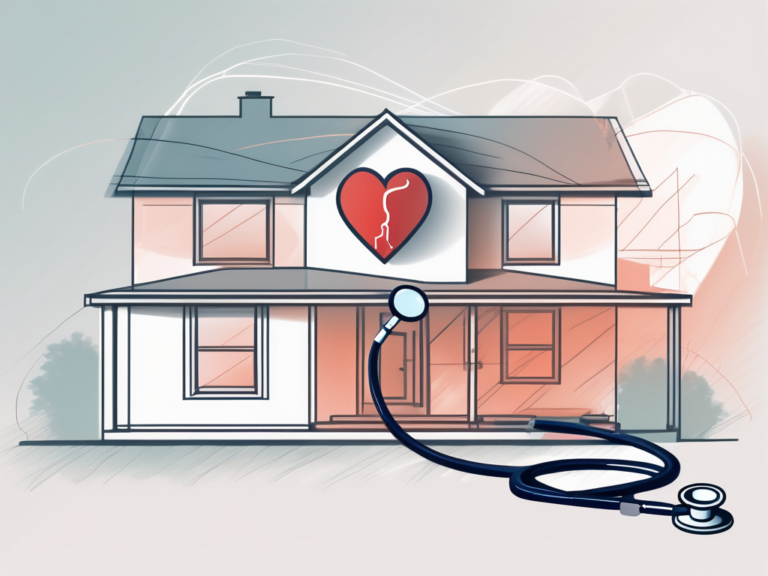How to Check Your Heart at Home: A Comprehensive Guide
Your heart is the engine that keeps your body running smoothly. It pumps oxygen-rich blood to every corner of your body, ensuring that all your organs and tissues receive the nourishment they need to function optimally. Taking care of your heart is crucial for overall well-being and longevity. In this comprehensive guide, we will explore the importance of heart health, learn how to monitor your heart at home, interpret your heart health results, know when to seek medical help, and discover lifestyle changes to maintain a healthy heart.
Understanding the Importance of Heart Health
Your heart plays a pivotal role in your body’s overall health and functioning. It is a muscular organ that contracts and relaxes to circulate blood throughout your body. By pumping blood, the heart delivers nutrients and oxygen while removing waste products. Understanding the significance of heart health empowers you to take proactive steps in caring for this vital organ.
The Role of the Heart in Your Body
Our heart works tirelessly around the clock, beating approximately 100,000 times per day. It is responsible for delivering oxygen and nutrients to every cell in our body. Along with the circulatory system, the heart plays a crucial role in maintaining overall health by ensuring the proper functioning of other vital organs.
Did you know that the heart is not just a pump? It is an intricate network of blood vessels, valves, and chambers that work together to keep our bodies functioning optimally. The heart’s four chambers, the left and right atria and ventricles, work in perfect harmony to ensure that oxygen-rich blood is pumped to the rest of the body while oxygen-depleted blood returns to the lungs to be reoxygenated.
Common Heart Conditions and Symptoms
Heart health issues can significantly impact our well-being and quality of life. Familiarizing yourself with common heart conditions and their symptoms allows for early detection and intervention. Conditions like high blood pressure, coronary artery disease, irregular heart rhythms, and heart failure require prompt medical attention.
High blood pressure, also known as hypertension, is a common heart condition that affects millions of people worldwide. It occurs when the force of blood against the walls of the arteries is consistently too high, putting strain on the heart and blood vessels. If left untreated, hypertension can lead to serious complications such as heart attack, stroke, and kidney problems.
Another prevalent heart condition is coronary artery disease, which occurs when the arteries that supply blood to the heart become narrow or blocked due to the buildup of plaque. This can restrict blood flow to the heart, leading to chest pain, shortness of breath, and even heart attacks. It is essential to recognize these symptoms and seek medical attention promptly to prevent further damage to the heart.
Basic Tools for Heart Monitoring at Home
Advances in technology have made it possible for us to monitor our heart health from the comfort of our homes. Let’s explore some basic tools that can assist in this endeavor.
When it comes to monitoring your heart health, a blood pressure monitor is a valuable tool to have at your disposal. This device measures the force of blood against the walls of your arteries, giving you a clear picture of your cardiovascular health. By regularly checking your blood pressure, you can determine if it falls within a healthy range or requires medical attention. It’s important to note that high blood pressure, also known as hypertension, can increase your risk of heart disease and stroke. Therefore, keeping a close eye on your blood pressure is crucial for maintaining a healthy heart.
Using a Blood Pressure Monitor
A blood pressure monitor consists of an inflatable cuff that is wrapped around your upper arm and a digital display that shows your blood pressure readings. To use it, simply wrap the cuff around your arm, position it correctly, and press the start button. The cuff will inflate and then slowly deflate, while the monitor measures your blood pressure. Once the measurement is complete, the monitor will display your systolic and diastolic blood pressure readings, as well as your heart rate. It’s a quick and painless process that can provide you with valuable insights into your heart health.
In addition to blood pressure monitors, another tool that can help you monitor your heart health is a pulse oximeter. These small devices are designed to measure the oxygen saturation levels in your blood, giving you an indication of how efficiently your heart is delivering oxygen throughout your body. Low oxygen saturation levels can indicate an underlying health issue and warrant immediate attention. By regularly using a pulse oximeter, you can keep track of your oxygen levels and take appropriate action if necessary.
The Role of Pulse Oximeters
Pulse oximeters work by emitting a beam of light through your fingertip or earlobe. The light passes through your skin and blood vessels, and a sensor on the other side of your finger or earlobe detects the amount of light that is absorbed. Based on this information, the pulse oximeter calculates your oxygen saturation level, which is expressed as a percentage. A normal oxygen saturation level is typically between 95% and 100%. If your oxygen saturation level falls below this range, it may indicate a problem with your heart or lungs, and you should consult a healthcare professional for further evaluation.
In the digital age, smart devices and heart rate apps have become increasingly popular for heart monitoring. These devices offer a convenient way to track your heart rate throughout the day, providing valuable data for self-awareness and any necessary medical follow-up. Whether it’s a smartwatch, fitness tracker, or smartphone app, these tools allow you to monitor your heart rate in real-time, giving you insights into how your heart responds to different activities and situations.
Smart Devices and Heart Rate Apps
Smart devices and heart rate apps use various sensors, such as optical sensors or electrodes, to detect and measure your heart rate. They can provide continuous heart rate monitoring during exercise, sleep, and daily activities, allowing you to identify patterns and trends in your heart rate. This information can be particularly useful if you have a pre-existing heart condition or if you’re looking to improve your cardiovascular fitness. By tracking your heart rate over time, you can make informed decisions about your lifestyle and seek medical advice if necessary.
It’s important to remember that while these tools can be helpful for monitoring your heart health at home, they are not a substitute for professional medical advice. If you have any concerns about your heart health or if you experience any unusual symptoms, it’s always best to consult with a healthcare professional. They can provide you with a comprehensive assessment and guide you on the appropriate steps to take for maintaining a healthy heart.
Steps to Check Your Heart at Home
Monitoring your heart health at home is a proactive step towards maintaining a healthy heart. Let’s delve into the steps you can take to ensure a comprehensive assessment.
Measuring Your Heart Rate
To measure your heart rate, place your index and middle fingers on your wrist or neck. Count the number of beats you feel within a designated time frame, usually a minute. A normal resting heart rate ranges between 60 and 100 beats per minute. Deviations from the norm may require medical attention.
Checking Your Blood Pressure
Utilizing a blood pressure monitor, wrap the cuff around your upper arm as per the device’s instructions. Inflate the cuff and let it deflate slowly. Record both the top number (systolic pressure) and the bottom number (diastolic pressure). Normal blood pressure falls within the range of 90/60 mmHg to 120/80 mmHg.
Monitoring Your Oxygen Saturation
Using a pulse oximeter, place the device on your finger as instructed. The oximeter will measure the oxygen saturation levels in your blood and display the results. Normal oxygen saturation levels range from 95% to 100%. If your levels fall below this range, consult a healthcare professional.
Now that you have learned the basic steps to check your heart at home, let’s explore some additional information that can help you better understand the importance of monitoring your heart health.
Regularly monitoring your heart rate can provide valuable insights into your overall cardiovascular health. By keeping track of your heart rate over time, you can identify any irregularities or changes that may require further investigation. For example, a consistently high resting heart rate could be a sign of an underlying condition, such as hypertension or an overactive thyroid. On the other hand, an unusually low heart rate may indicate bradycardia, which can be a symptom of an underlying heart problem. By being aware of these potential red flags, you can take proactive steps to address any issues and seek medical advice if necessary.
In addition to measuring your heart rate, checking your blood pressure is another important aspect of monitoring your heart health. High blood pressure, also known as hypertension, is a common risk factor for heart disease. By regularly monitoring your blood pressure at home, you can keep track of any fluctuations and take appropriate measures to manage it. Lifestyle modifications, such as adopting a healthy diet, engaging in regular exercise, and reducing stress, can help lower your blood pressure and reduce the risk of heart disease. However, if your blood pressure consistently remains high despite these lifestyle changes, it is essential to consult a healthcare professional for further evaluation and potential treatment options.
Interpreting Your Heart Health Results
Now that you have gathered heart health data, it’s essential to understand the significance of your results. Interpreting these results helps you take appropriate actions for a healthier heart.
When it comes to assessing your heart health, there are several key factors to consider. One of the most important indicators is your heart rate. Your heart rate provides valuable insights into your overall cardiovascular health. A high resting heart rate may indicate stress, dehydration, or an underlying health condition. On the other hand, a consistently low heart rate could suggest cardiovascular fitness or potential issues with the heart’s electrical system.
In addition to heart rate, understanding your blood pressure readings is crucial. Your blood pressure readings provide information about the force your blood exerts on your arterial walls. High blood pressure, also known as hypertension, can strain your heart and lead to serious health complications such as heart disease, stroke, or kidney problems. On the other hand, low blood pressure, also known as hypotension, may impact your organ function and cause symptoms like dizziness or fainting. Understanding these readings empowers you to make necessary lifestyle changes or seek medical advice to maintain optimal blood pressure levels.
Another significant aspect of heart health is oxygen saturation levels. Oxygen saturation reflects how well your heart is pumping oxygen throughout your body. It is measured by a small device called a pulse oximeter, which clips onto your finger or earlobe. Low saturation levels may indicate underlying respiratory or circulatory issues, such as lung disease or heart failure. By understanding your oxygen saturation levels, you can determine whether further medical investigation is necessary and take appropriate steps to improve your heart’s oxygen supply.
Remember, interpreting your heart health results is the first step towards a healthier heart. By understanding what your heart rate, blood pressure, and oxygen saturation levels mean, you can make informed decisions about your lifestyle, seek medical advice when needed, and take proactive measures to improve your cardiovascular well-being.
When to Seek Medical Help
While monitoring your heart health at home is crucial, it’s essential to know when it’s time to seek medical help and consult a healthcare professional.
When it comes to matters of the heart, it’s important to be aware of warning signs and symptoms that may indicate a more serious heart health issue. Pay close attention to any chest pain, as it can be a sign of a heart attack or angina. Shortness of breath, especially during physical activity or while at rest, should also raise concern. Additionally, if you experience dizziness, fatigue, or palpitations, it’s crucial to seek medical attention immediately.
However, it’s not just the presence of these warning signs that should prompt you to seek medical help. Regular check-ups with a healthcare professional are vital for monitoring your heart health comprehensively. These appointments allow medical experts to assess your overall cardiovascular well-being and provide personalized advice tailored to your needs.
During these check-ups, your healthcare provider will conduct a thorough examination, which may include assessing your blood pressure, cholesterol levels, and heart rate. They may also order additional tests, such as an electrocardiogram (ECG) or stress test, to evaluate your heart’s function and identify any underlying issues.
Moreover, these appointments provide an opportunity for you to discuss any concerns or questions you may have about your heart health. Your healthcare provider can offer guidance on lifestyle modifications, such as diet and exercise, that can help improve your heart health and reduce the risk of cardiovascular diseases.
Remember, early detection and intervention are key when it comes to heart health. By seeking medical help and attending regular check-ups, you are taking proactive steps towards maintaining a healthy heart and overall well-being.
Maintaining Heart Health
Caring for your heart extends beyond monitoring and interpreting data. Making lifestyle changes significantly contributes to maintaining a healthy heart.
Lifestyle Changes for a Healthy Heart
A heart-healthy lifestyle includes adopting habits such as regular physical activity, managing stress levels, prioritizing sufficient sleep, and avoiding tobacco use. Small changes can have a direct positive impact on your cardiovascular health.
The Role of Diet and Exercise
A nutrient-rich diet plays a vital role in maintaining heart health. Incorporate fruits, vegetables, whole grains, and lean proteins into your meals. Combine a balanced diet with regular exercise to strengthen your heart muscle, lower blood pressure, and enhance overall cardiovascular fitness.
Stress Management and Heart Health
High levels of stress can adversely affect heart health. Engage in activities that help you relax and manage stress effectively. Practice mindfulness techniques, indulge in hobbies, and ensure you have a support system in place to promote emotional well-being.
Did you know that physical activity not only benefits your heart, but it also has a positive impact on your mental health? When you engage in regular exercise, your body releases endorphins, which are known as the “feel-good” hormones. These endorphins help reduce stress, anxiety, and symptoms of depression, making you feel happier and more relaxed.
In addition to exercise, getting enough sleep is crucial for maintaining heart health. During sleep, your body repairs and rejuvenates itself, including your heart and blood vessels. Lack of sleep can lead to an increased risk of developing heart disease, high blood pressure, and other cardiovascular problems. So, make sure you prioritize a good night’s sleep to keep your heart in top shape.
By following this comprehensive guide, you can proactively monitor your heart health at home. Remember, knowledge is power, and taking care of your heart is an investment in your overall well-being. Embrace a heart-healthy lifestyle, and make your heart the center of your health journey.






